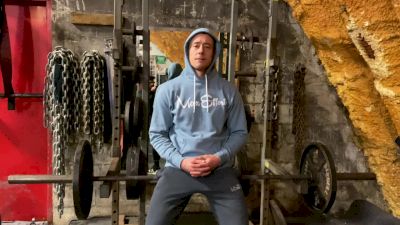Coach Myers Wrestling S&C: The Zercher Squat
Coach Myers Wrestling S&C: The Zercher Squat
Coach Myers is back with an explanation on one of the most important lifts a wrestler can do: the Zercher Squat.
Unlock this article, live events, and more with a subscription!
Already a subscriber? Log In
While I have always been a big proponent of wrestlers utilizing unilateral (feet staggered) squat variations such as Bulgarian Split Squats and Pistols due to the balance and stability required, Bilateral barbell squats definitely should have their place in every wrestler’s strength regimen as well.
I program traditional Back Squats and Front Squats during the offseason, but my absolute favorite barbell squat variation for wrestlers is the dreaded Zercher Squat.
What is the Zercher Squat?
Technique
Place a loaded bar on a low rack set to the approximate height of your elbows when you are at the bottom of a squat. With a wide stance, cradle the bar in the crook of your elbows and place your crossed arms on your chest. Keep the bar close to your chest as you stand up, hipping in at the top. If you are pulling from blocks you can drop the bar at the top and reset. If using a rack, lower under control, then reset your hips before the next rep — no “touch and go.”
Why You Should Do It
Have you ever found yourself in on a shot, hips under you and a tremendous amount of downward pressure preventing you from finishing? That’s exactly the position of a Zercher Squat. Posterior chain, leg drive, and “squeezing” strength; this exercise was tailor-made for wrestlers.
Another benefit is the lack of spinal loading/compression due to the weight being in front of you rather than stacked high atop your vertebrae. This is one of the reasons that the Zercher is the only barbell squat I keep in my programming during the season.
Why People Don’t Do It Enough
For starters, it’s uncomfortable. Some exercises “feel good,” but the Zercher just flat-out hurts. But if you can get strong in this particular position it will translate directly to strength on the mat. One way to alleviate some of the discomfort is to wear a sweatshirt or wrap a towel around the bar. Another reason people shy away from the Zercher is it’s an ego killer; you are not going to be able to use quite as much weight as on a traditional back squat, and there are no “easy” reps.
How You Should Do It
Do 2-3 sets of heavy weight in the 1-5 rep range. Use this front squat variation as a back squat substitute once a month during the offseason, or use as an accessory lower body strength movement for 2-3 weeks at a time every 6-8 weeks during the season.
Modifications
Youth wrestlers and less experienced athletes will probably have a tough time bracing their core properly to maintain good position. For youth wrestlers I recommend the following modifications:
Seated Med Ball Zercher
Have the athlete sit on a bench or lower plyo box and grasp a med ball in a body lock. The lock should be lower than normal, so the med ball is against their stomach rather than their chest. Cue them to flex their abs, squeeze the ball, then stand up explosively and extend their hips forward. Sets of 5-10 reps per set will work for young hammers.
Time Under Tension
When working with junior high wrestlers or even less experienced high school athletes, they may be ready to transition from the med ball to the barbell, but start them out slow. I recommend using an empty or light bar and have them utilize a 1/5/3 tempo. Start in the rack but then step back so once un-racked they will hold the bar the entire time. Come up at a normal speed (1 second concentric), lower slowly (5 seconds eccentric), and hold the bottom position for 3 seconds (isometric squat hold). This will help them master the positioning necessary to begin to load weight on the Zercher. Sets of 5-10 reps depending on strength and ability.
Coach Myers is the strength coach for the Ohio Regional Training Center at The Ohio State University. With the Ohio RTC since 2012, he served as Ohio State Wrestling’s primary strength coach from 2014-18, helping the Buckeyes win three Big Ten titles, their first-ever team NCAA championship, and two runner-up finishes.
A certified strength and conditioning specialist (CSCS), Coach Myers owns the Old School Gym in Pataskala, OH, and is a founding partner of top supplement company Max Effort Muscle. Follow him on Instagram and Facebook, and learn more about his strength and conditioning programs for wrestlers of all ages here.
